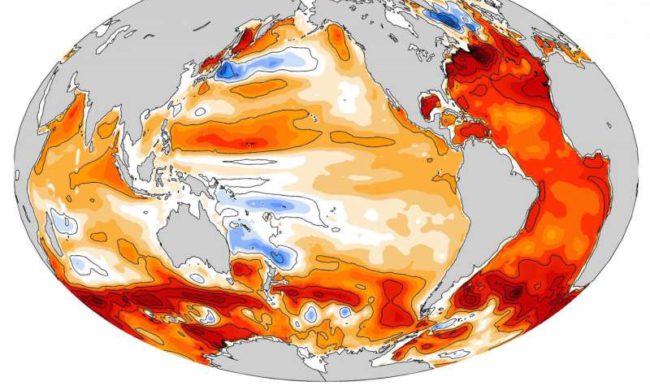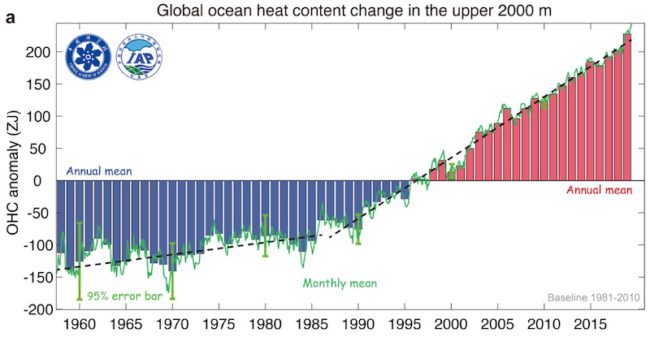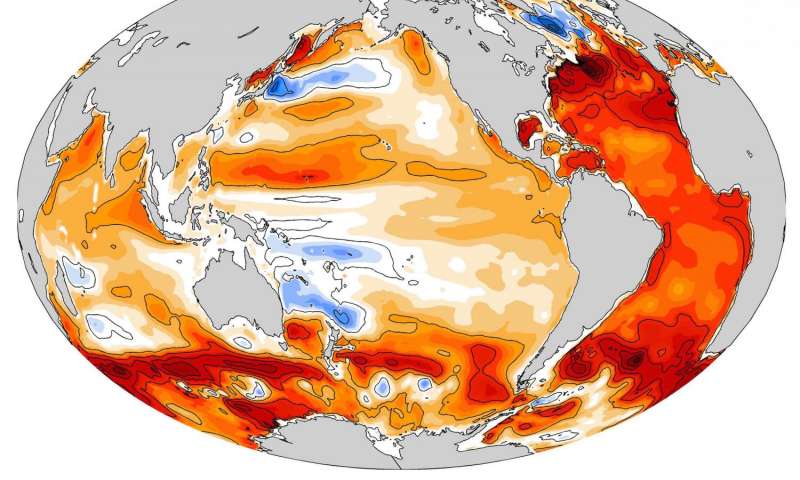
The latest measurements via the Argo Float network confirm that the oceans right around our planet are warming at an accelerated rate. Ocean warming is now a huge concern.
Global ocean temperature is not only increasing, but it is speeding up.
An international team of 14 scientists from 11 institutes across the world have analysed the latest data and published it within Advances in Atmospheric Sciences on 13th January 2020.
Record-Setting Ocean Warmth Continued in 2019
It was almost one year ago that I was writing about how our oceans are warming. At that time the understanding was that the oceans were heating up far faster that the IPCC AR5 previously indicated back in 2013.
Here we are now one year later. This new analysis shows the world’s oceans were the warmest in 2019 than any other time in recorded human history. That is specifically a measurement between the surface and a depth of 2,000 meters.
Because the oceans are the main repository of the Earth’s energy imbalance, measuring ocean heat content (OHC) is one of the best ways to quantify the rate of global warming.
Key Insight
The ocean heat anomaly (0−2000 m) in 2019 was 228 Zetta Joules (ZJ, 1 ZJ=1021 Joules) above the 1981−2010 average and 25 ZJ above 2018.
What does that mean?
The ocean temperature is about 0.075 degrees Celsius above the 1981-2010 average.
That sounds tiny.
That is vast. This is an increase for the oceans of the entire planet. This change means that the ocean would have taken in 228,000,000,000,000,000,000,000 (228 Sextillion) Joules of heat.
“That’s a lot of zeros indeed. To make it easier to understand, I did a calculation. The Hiroshima atom-bomb exploded with an energy of about 63,000,000,000,000 Joules. The amount of heat we have put in the world’s oceans in the past 25 years equals to 3.6 billion Hiroshima atom-bomb explosions.” said CHENG Lijing, lead paper author and associate professor with the International Center for Climate and Environmental Sciences at the Institute of Atmospheric Physics (IAP) of the Chinese Academy of Sciences (CAS). Cheng is also affiliated with CAS’s Center for Ocean Mega-Science. “This measured ocean warming is irrefutable and is further proof of global warming. There are no reasonable alternatives aside from the human emissions of heat trapping gases to explain this heating.”
(Side note: The atom bomb comparison is not media hype, (for example see the CNN story here) the lead author of the paper started that)
The Ongoing Trend
Below is a graph from the published study that illustrates what is happening.

Within the above the units measured are Zetta Joules (ZJ=1021 Joules). The two black dashed lines are the linear trends over 1955–86 and 1987−2019, respectively
Then and Now – The measured differences
This next diagram below (b) illustrates the Ocean heat content anomaly in 2019. This is relative to their 1981−2010 baseline. Below that (c) shows you the difference of ocean heat content at the upper 2000 m between 2019 and 2018.

Impact – This is Deeply concerning
“It is critical to understand how fast things are changing,” said John ABRAHAM, co-author and professor of mechanical engineering at the University of St. Thomas in the United States. “The key to answering this question is in the oceans — that’s where the vast majority of heat ends up. If you want to understand global warming, you have to measure ocean warming.”
2019 broke the previous records set in prior years for global warming, and the effects are already appearing in the form of more extreme weather, rising sea levels and harm to ocean animals.
“Global warming is real, and it’s getting worse,” Abraham said. “And this is just the tip of the iceberg for what is to come. Fortunately, we can do something about it: We can use energy more wisely and we can diversify our energy sources. We have the power to reduce this problem.”
It is not too late – we can make a difference
According to the researchers, humans can work to reverse their effect on the climate, but the ocean will take longer to respond than atmospheric and land environments. Since 1970, more than 90% of global warming heat went into the ocean, while less than 4% of the heat warmed the atmosphere and land where humans live.
“Even with that small fraction affecting the atmosphere and land, the global heating has led to an increase in catastrophic fires in the Amazon, California and Australia in 2019, and we’re seeing that continue into 2020,” Cheng said.
Marine Heat Waves
“The global ocean warming has caused marine heat waves in Tasman Sea and other regions.”
One such marine heat wave in the North Pacific, dubbed “the blob,” was first detected in 2013 and continued through 2015.
“The blob is documented to have caused major loss of marine life, from phytoplankton to zooplankton to fish — including a 100 million cod — to marine animals, such as whales,” said Kevin TREMBERTH, co-author and distinguished senior scientist at the National Center for Atmospheric Research in the United States. “These manifestations of global warming have major consequences.”
Trenberth also noted that a hot spot in the Gulf of Mexico in 2017 spawned Hurricane Harvey, which led to 82 deaths and caused about $108 billion in damages according to the Rice Kinder Institute for Urban Research. The following year, a hotspot in the Atlantic Ocean near the Carolinas led to Hurricane Florence. According to Moody’s Analytics, an economic research organization, the storm caused 53 deaths and between $38 and $50 billion in economic damage.
“The price we pay is the reduction of ocean-dissolved oxygen, the harmed marine lives, strengthening storms and reduced fisheries and ocean-related economies,” Cheng said. “However, the more we reduce greenhouse gasses, the less the ocean will warm. Reduce, reuse and recycle and transferring to a clean energy society are still the major way forward.”
Further Reading
- Details regarding the Argo Float Network
- Study 13th January 2020: Record-Setting Ocean Warmth Continued in 2019
- In the media …
